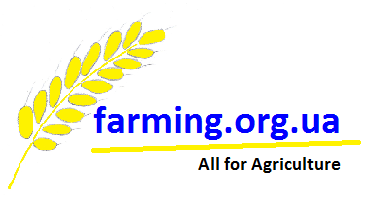|
Breeders of Strube,
thanks to the use of innovative technologies, had breed new wheat
varieties that have a very high genetic potential for yield. These
varieties can produce the largest yield, and therefore profit per
hectare. By these varieties, it is possible not only to increase profits
but also to reduce risks! When growing such varieties - the income will
be maximally possible. In this article, we will look at these unique
modern varieties of wheat that can be sown, both in the fall and spring
- facultative wheat!
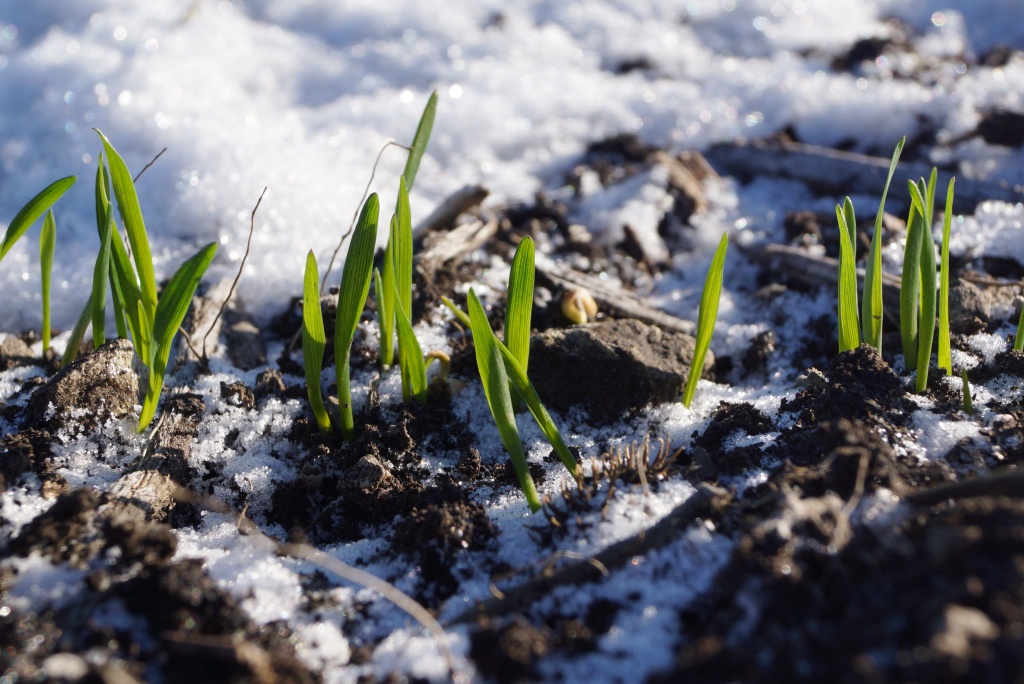
Late wheat planting have become very actual in recent years due to
climate changes. The climate has changed, so the sowing time for winter
wheat has changed! In many regions, now in autumn there is not enough
moisture for emergence of wheat seeds , due to drought. In such cases,
using Strube WeW® facultative wheat varieties is very beneficial. As
this wheat is just for such late sowing! At the photo - a very late
sowing of wheat - the shooting date is December 11th (In the temperate
climatic zone, Ukraine). Due to the fact that there was no moisture in
the soil for a long time, seedlings were obtained only in December (©
photo Dr. Oleksii Orlov)
What biological forms do wheat have?
In wheat, the following biological forms
are distinguished: winter, spring, and facultative.
Winter wheat
- these are wheat that, to undergo the vernalization process, in the
initial period of development, require low temperatures from -1 to + 10
°C for 25-50 days until stable negative temperatures coming, and wheat
harvest will be received not earlier as in next year.
During spring sowing, winter wheat, as a
rule, does not tillering and does not forming a stem and an ear.
Spring wheat
- such wheat to go through the vernalization stage, require higher
temperatures from +5 to + 20 °C for 7-20 days. Therefore, spring wheat
is sown in the spring and harvested in the same year.
Facultative WeW® wheat
from Strube are wheat that go through the
vernalization stage at temperatures from + 3 to + 15 °C. For regions
with mild winters (in
the temperate zone:
Northern and Central USA, Southern and Central
Canada,
Kazakhstan
and Uzbekistan,
entire territory of Ukraine, Central and Southern Russia, China,
Northern and Central Europe, Germany, France, Poland, England and
Ireland, Central Norway, Japan and Far East, Southern Argentina,
Southern New Zealand and Tasmania), Strube offers a number of WeW®
facultative wheat varieties that normally grow and develop and yield
crops in both spring and autumn sowing.
The use of such facultative wheat is of
great importance and can significantly reduce risks and reduce the
intensity of labour of farmers in the autumn and spring periods, as well
as during harvesting. As these work periods become more flexible.
It is very important to sow the WeW®
facultative wheat in the fall, since, having received some development
from the fall, such wheat will be better using winter - spring stocks of
moisture and nutrients than when sown in spring.
With the coming of steady warm weather in
the spring, such wheat grow vegetative mass faster and less suffer from
spring drought than typical spring wheat.
When sowing facultative wheat, it is very important
that it will be possible the transfer of some field works to the fall
that will significantly reduces during the spring sowing period works.
What
gives for farmer and agro-industrialist the using of facultative WeW®
wheat in the production?
Due to climate changes, in the fall very
often the soil is dry and not enough moisture to produce wheat
seedlings. Therefore, many "wait until the last" and sow winter wheat
very late. And such crops very often freeze in the winter due to
insufficient development in the fall. But present a special varieties of
wheat that are designed specifically for such sowing and tolerate for
late sowing in autumn, early winter and February - these are WeW®
facultative wheat from Strube.
In the case of late sowing of ordinary
winter wheat, farmers very often face various problems that do not allow
them to be sown in time, and consequently lead to loss of profit.
The soil can be very wet - and because of
this it is impossible to sow normally.
Often in late autumn it is generally
impossible to sow ordinary winter wheat in time due to bad and very
rainy weather or due to drought.
With later sowing of ordinary winter
wheat, seedlings of ordinary wheat varieties are poorly developed and
there is a danger of their freezing in winter.
The solution to these problems of late
sowing - requires modern and flexible solutions.
One of such solution is Strube WeW®
facultative wheat (alternative wheat).
Such wheat can be sown without risks much
later than ordinary winter wheat - when the adverse conditions are over.
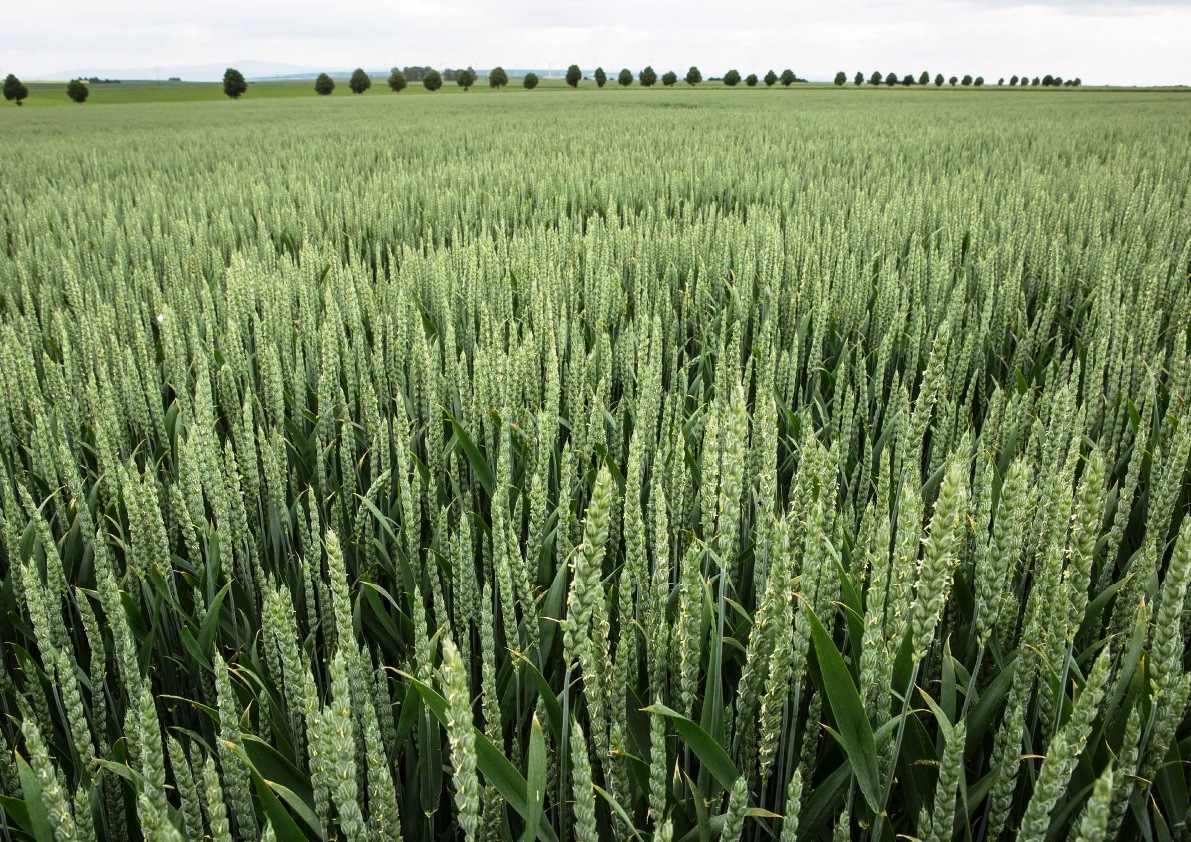
Photo source:
Strube
Using in wheat production of WeW® facultative varieties from Strube -
make it possible to sow wheat very late in autumn and early winter, as
well as in February windows. Especially this is important for those who
grow later crops - sugar beets, corn, sorghum and soy. Since, in this
case, the field is will be free from crop very late. At the photo there
is a highly productive field of facultative wheat with a yield potential
of about 10 t/ha
It is especially beneficial to use WeW® facultative wheat in the
production for sugar beet growers.
Since this makes it possible to sow wheat without risks after harvesting
sugar beets.
It also makes it possible to get a big profit from growing sugar beets,
since with later harvesting beets, the sugar yield per hectare will be
higher.
This is especially important when growing hybrids of sugar beet NZ, N
and E-types, which form significantly more sugar, in case of longer
growing periods (see the following photo).
Sugar beet is a very good in crop rotation for wheat, it leaves a large
amount of nutrients in the soil.
Soils after sugar beets are considered very good for the subsequent
sowing of wheat.
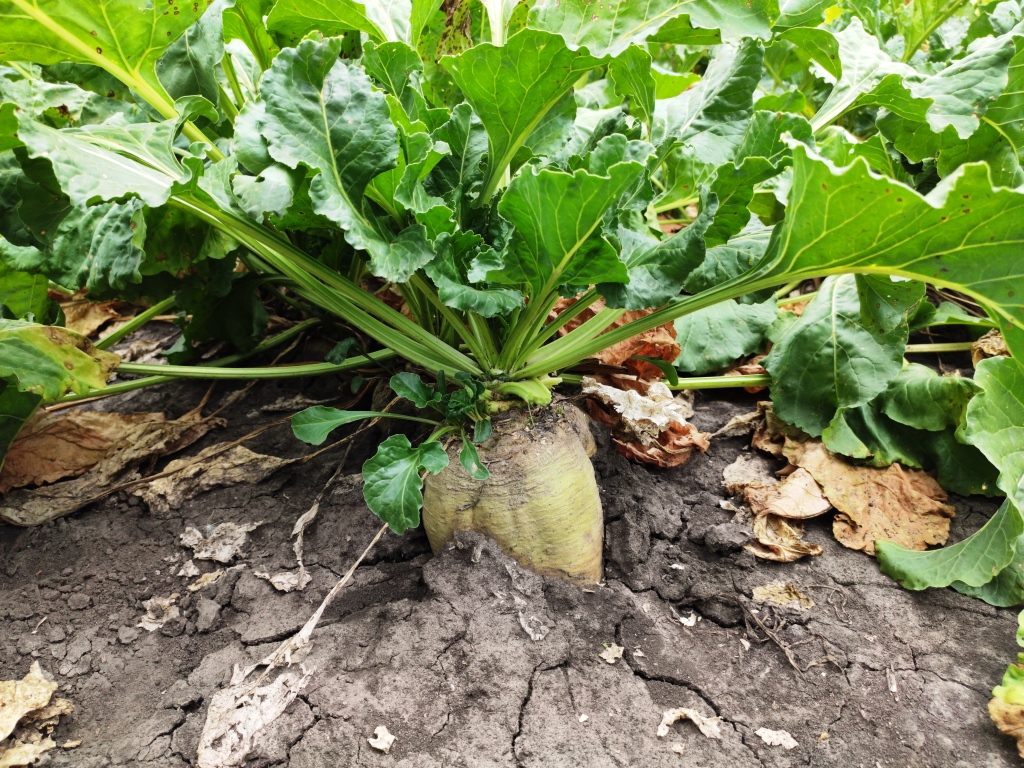
By using of later WeW® facultative wheat sowing -
makes it possible to later harvest of sugar beets, which when harvested
later, can form an additional root crop of more than 2 t/ha and
accumulate more sugar, which is about 7-15 euros per hectare additional
profit! The photo shows a Vok
sugar beet variety from Strube (NZ type), which showed a yield of 87.0
t/ha on an area of 68 ha in Svitanok Farm, 2018, Ukraine (©
photo Dr. Oleksii Orlov)
What are the placing of WeW® facultative wheat in
crop rotation?
The use of such wheat gives great advantages, since it becomes possible
to sow wheat even after late harvested crops.
Most modern farmers in Europe who grow late crops (for example, corn,
soybeans, sugar beets) sow facultative wheat for 10-20% of the total
wheat sowing area. And now, due to climatic changes, the area of
sowing facultative wheat is significantly increasing every year.
The best previous crop in crop rotation for WeW® facultative wheat are
broadleaf crops, soybeans, sunflowers, and sugar beets in particular.
What
is the time of sowing facultative wheat WeW®?
The basic rule of for sowing of facultative wheat is that “you should
never sow early - you must always sow late.” The using of Strube
facultative wheat varieties gives very great flexibility in sowing dates
for farmers. If autumn conditions are very unfavourable for sowing
wheat, then having facultative wheat seeds available, you can wait with
virtually no restrictions - from mid of October until spring.
The following table shows the possible sowing dates for WeW® facultative
wheat varieties - they are very different from typical wheat.
Comparison of sowing dates of ordinary winter wheat and
facultative
WeW®
wheat
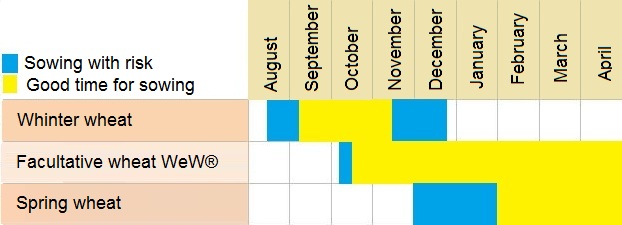
Source: BayWa/SAATEN-UNION, 2013
What
is the winter stress hardiness in case of such late sowing of
WeW®
facultative wheat?
Winter hardiness of such crops is quite high. According to German
farmers, even sowing such varieties in January has never brought
problems over the past 10 years. In Germany, none of the facultative
wheat varieties were ever seriously damaged in the winter. Now in the
temperate zone regions, in connection with climate change, conditions
have developed where there is practically no seriously danger of
freezing of such wheat varieties.
Will there be delays in harvesting time when using
WeW® facultative wheat and late sowing?
Of course, when sowing of facultative wheat in December or January, with
a relatively warm winter, wheat plants will have a developmental deficit
compared to winter wheat, which was sown at the optimum time. But all
varieties of facultative wheat grow so fast and well that the
development deficit is compensated until the harvest.
Even if facultative varieties are sown in February. This is due to their
better tillering and faster growth of such varieties of facultative
wheat.
The harvesting time for wheat in the late sowing of facultative
varieties almost coincides with ordinary winter wheat. This is due to
the very intensive starting growth of facultative wheat, which
compensates for the development deficit compared to ordinary winter
wheat sown in October.
One of the main competitive advantages of
WeW®
facultative wheat is its very stable grain quality. Grains of such
varieties have very stable indicators of the number of falls.
This means that facultative varieties can not be harvested immediately
after ripening - they do not lose grain quality when delayed harvesting.
In ordinary varieties of winter wheat, this is not so - for example, a
good rainfall after ripening the crop significantly reduces the rate of
fall of the grain.
Although
WeW®
facultative wheat can be harvested later than ordinary winter wheat,
cases of lodging of crops are very rare.
What is the yield level
of facultative
WeW®
wheat?
Facultative wheat, with late sowing, usually gives a grain harvest that
is average for winter wheat in the farm, but can significantly exceed
the yield of any spring wheat, due to the use of winter-spring moisture
and an early effective start of growth in spring.
Facultative wheat yields are usually comparable to regular late-ripening
winter wheat in case when sowing facultative wheat from November to
February.
When sowing a facultative wheat at a later date, the yield of the
facultative wheat will be comparable to the yield of spring wheat.
According to the sowing dates, the costs for the planned yield
(fertilizers, plant protection products, agrochemistry, and so on) are
calculated.
What are the varieties of facultative wheat? Description of facultative
wheat varieties WeW® from Strube
Lennox
(facultative wheat WeW®)

Photo source:
Strube
Wheat variety
Lennox, facultative WeW® wheat. Potential of yield -
more than 9.5 t/ha!
-
For spring-autumn sowing (facultative
wheat)
-
A good combination of crop stability
and plants health
-
Recommended for areas with high
rainfalls
-
Shoots appear earlier than on fields
with ordinary winter wheat
Advantages of wheat
variety Lennox
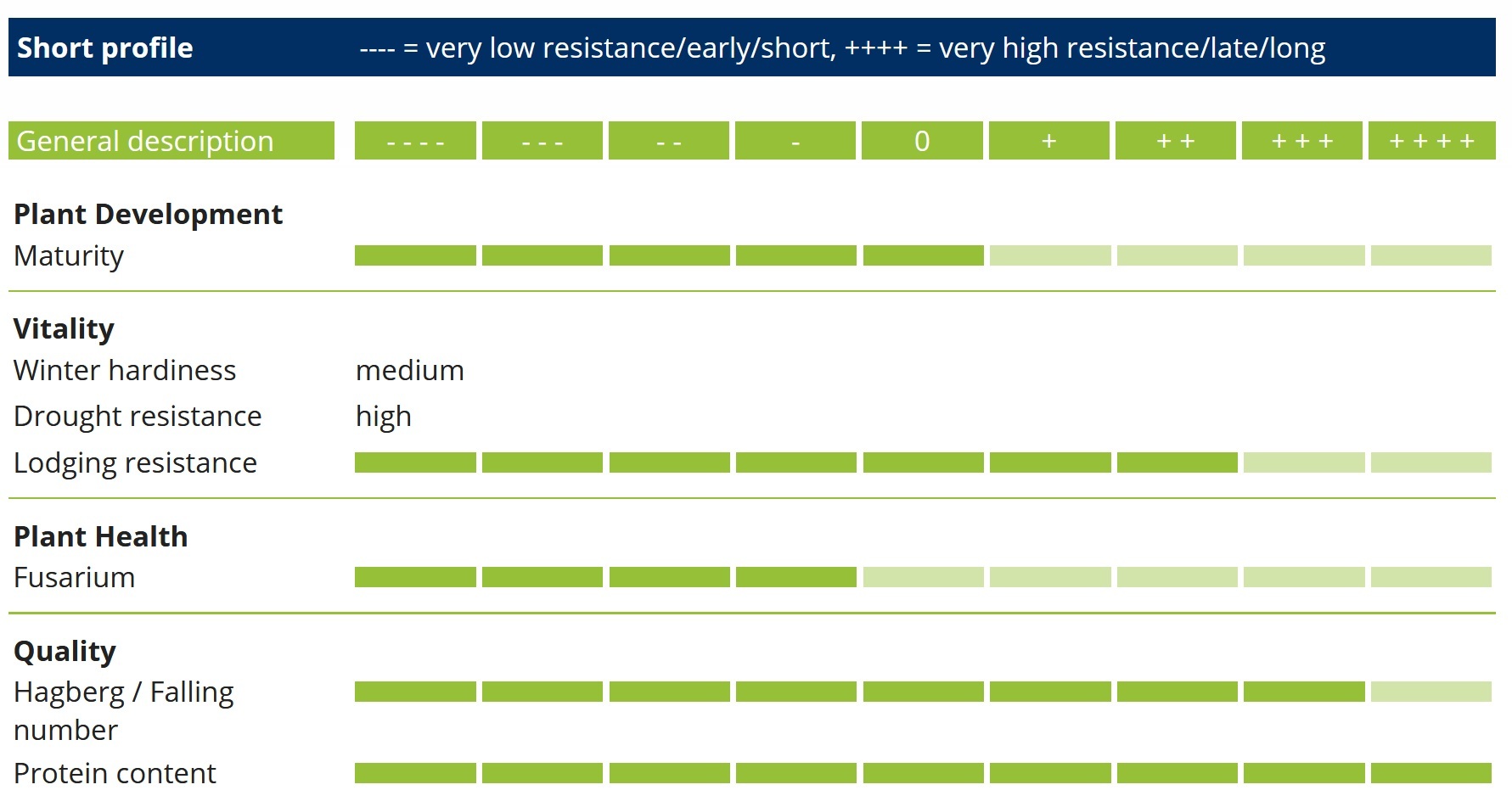
Source:
SAATEN-UNION

Wheat variety Lennox,
facultative wheat WeW®. This variety with proper growing technology is
capable of providing the highest yield and excellent profit! (© photo
Dr. Ivan Svydyniuk,
Strube, 06.14.2019, Ukraine)
Description of wheat
variety Lennox
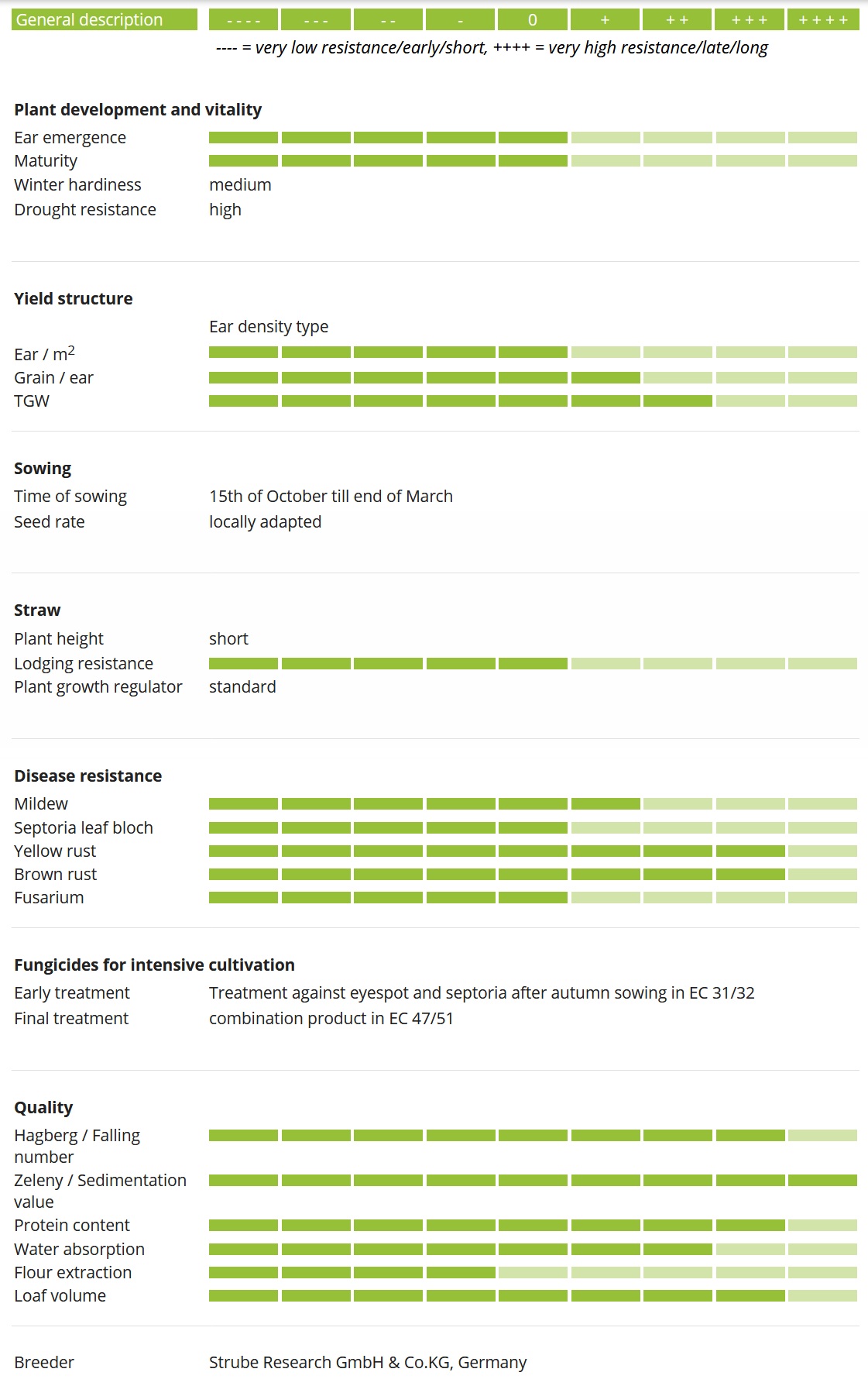
Source:
SAATEN-UNION
Time of
sowing and seed rate
of wheat
variety Lennox*
Seeding rate - "winter"
sowing of the Lennox variety
-
Early sowing (mid-October): 360-400
seeds / m2
-
Late sowing (November-December) -
(10.10-25.11): 450-550 seeds / m2
Seeding rate - "spring
sowing" (until 15.04) of the Lennox variety
-
After
autumn
frost - until mid-April: 400-450 seeds
/ m2
*These
time of sowing and seed rates for Ukrainian conditions (time of sowing
and seed rate must be locally adapted)
Matthus
(facultative
wheat WeW®)

Photo source:
Strube
Wheat variety
Matthus, facultative WeW® wheat.
Potential of yield
- more than 9.0 t/ha!
-
For spring-autumn sowing (facultative
wheat)
-
Shoots appear
earlier than on ordinary winter wheat
-
Good grain loading
-
Resistant to
drought and lodging
Advantages of wheat
variety
Matthus
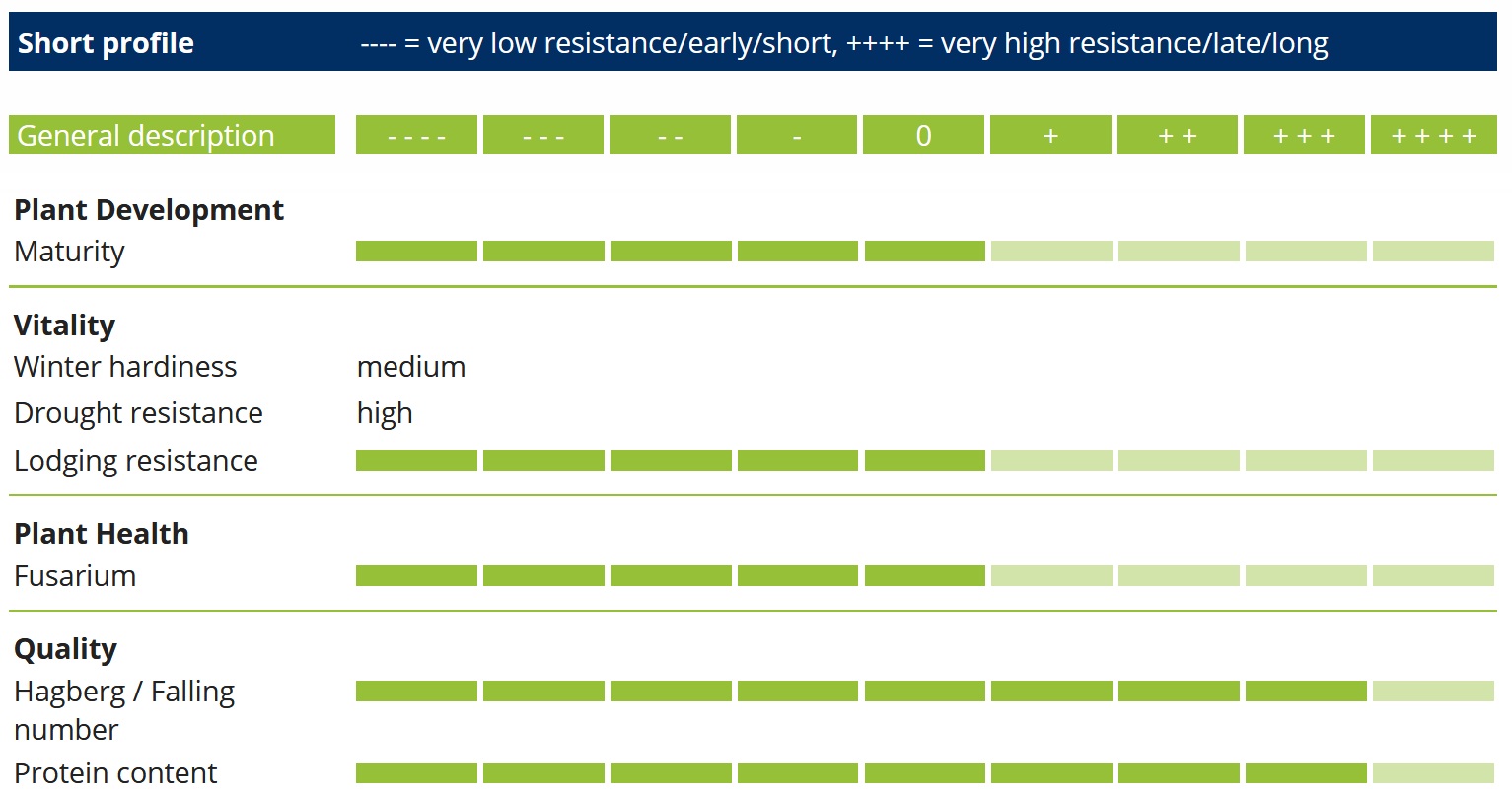
Source:
SAATEN-UNION

Wheat variety Matthus, facultative
wheat WeW®. Good German breeding and flexible sowing times are a
reduction of risks and a guarantee of obtaining high yields, while
observing the cultivation technology! (© photo
Dr. Ivan Svydyniuk,
Strube, 06.14.2019, Ukraine)
Description of wheat
variety
Matthus
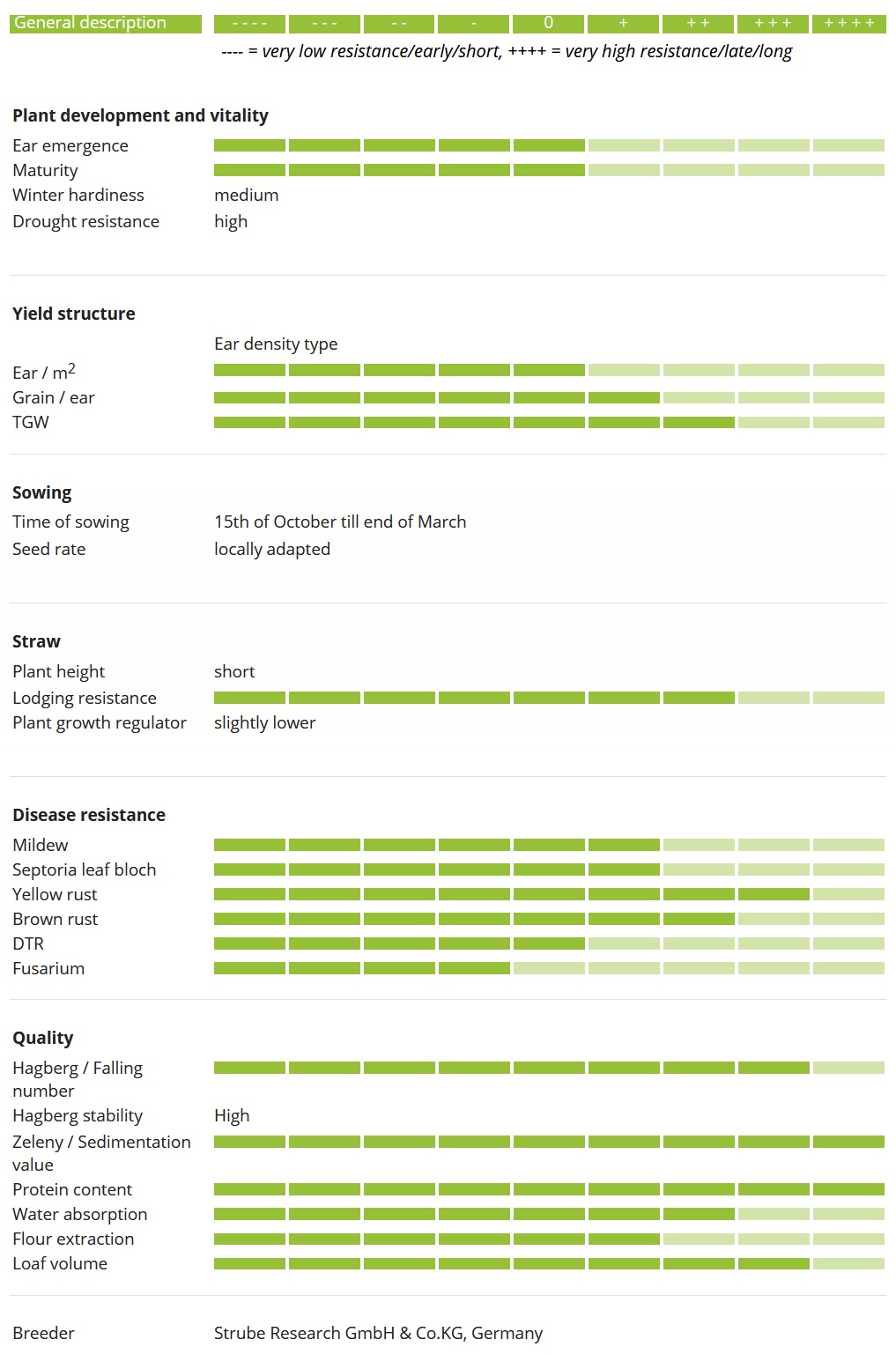
Source:
SAATEN-UNION
Time of
sowing and seed rate
of wheat
variety
Matthus*
-
Autumn
sowing (10.10-25.11): 450-550 seeds / m2
-
After
autumn
frost - until mid-April (until 15.04):
400-450 seeds / m2
*These
time of sowing and seed rates for Ukrainian conditions (time of sowing
and seed rate must be locally adapted)
Granus
(facultative
wheat WeW®)

Photo source:
Strube
Wheat variety
Granus, facultative WeW® wheat.
Potential of yield
- more than 9.0 t/ha!
-
For spring-autumn sowing (facultative
wheat)
-
High yield potential
-
Good baking qualities
-
For all growing areas in
the temperate climatic zone
Advantages of wheat
variety Granus
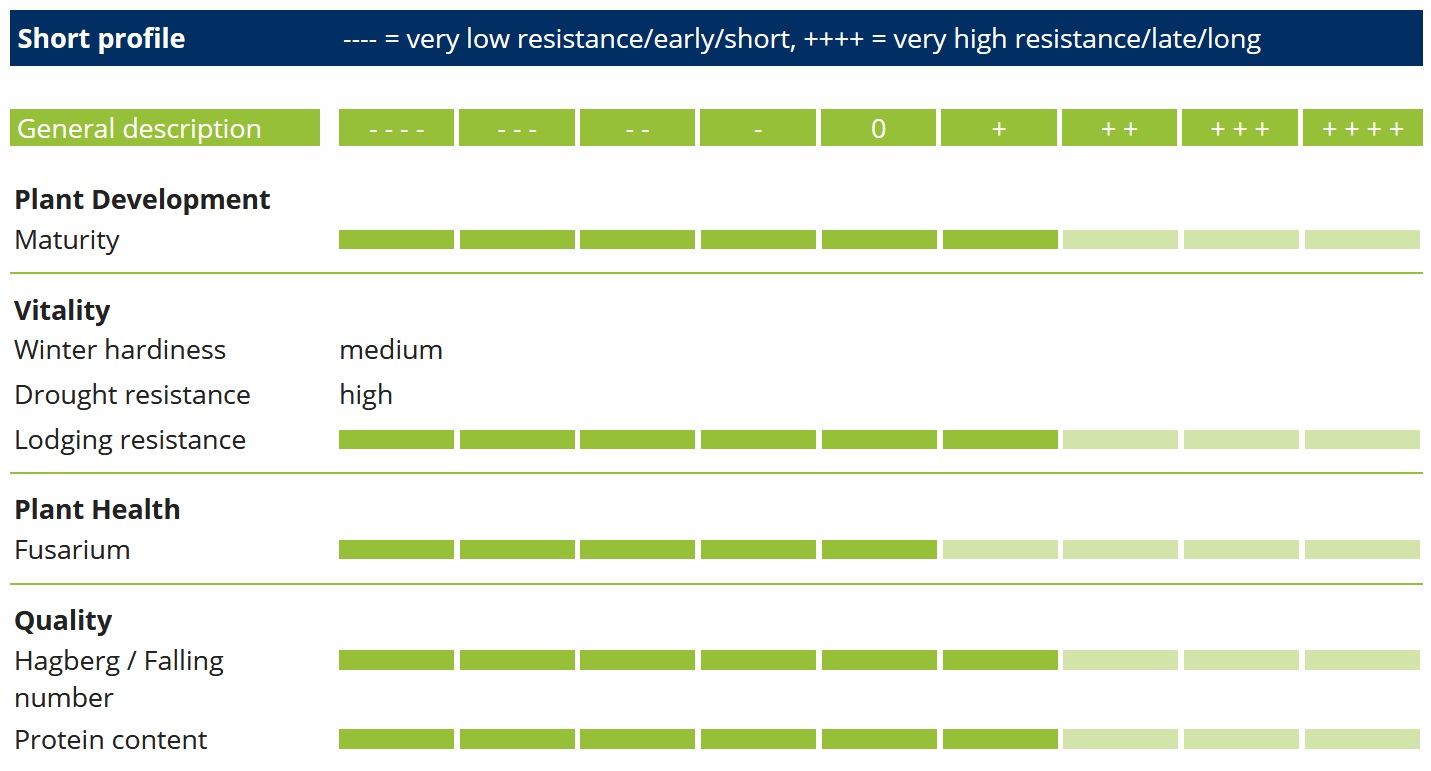
Source:
SAATEN-UNION

Wheat variety Granus, WeW®
facultative wheat. This variety is able to form a high yield with late
sowing and in case of the right technology (© photo
Dr. Ivan Svydyniuk,
Strube, 06.14.2019, Ukraine)
Description of wheat
variety Granus
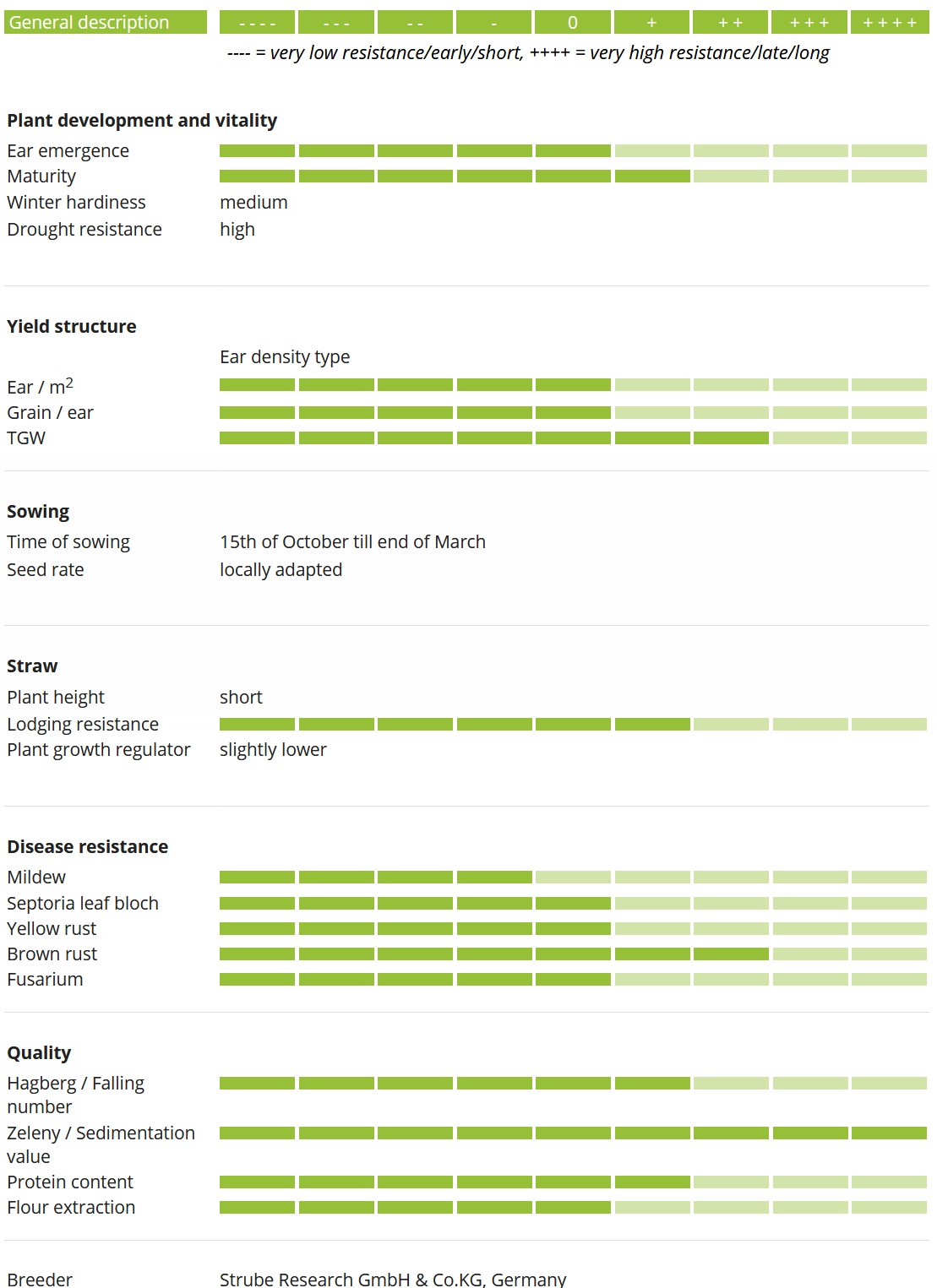
Source:
SAATEN-UNION
Time of
sowing and seed rate
of wheat
variety Granus*
-
Autumn
sowing (10.10-25.11): 450-550 seeds / m2
-
After
autumn
frost - until mid-April (until 15.04):
400-450 seeds / m2
*These
time of sowing and seed rates for Ukrainian conditions (time of sowing
and seed rate must be locally adapted)
The right selection and purchase of
WeW® facultative wheat varieties for late sowing can not only
significantly reduce risks and protect investments in wheat sowing, but
also, with the right approach, give a significant increasing in yield
compared to traditional spring wheat varieties!
For reducing of the risks of late
sowing, it is recommended to leave at least 20% of the area at the farm
for facultative wheat sowing (from the total wheat sowing). This will
significantly reduce the risks, but not reduce the profit from growing
wheat.
Ultimately, the use of
facultative wheat in production gives higher financial results and
ensures a stable profit flow without risks.
Contact
Strube for purchase WeW® facultative high-yield and profitable wheat
seeds!

Many thanks for
the help in preparing the article: Strube GmBH,
Dr. Lutz Gerrmann, Dr. Ivan Shvidinyuk, Dr. Vyacheslav Dimitrovó
-
For
purchase seeds, contact Strube:
-
-
+49 (0) 53 548-09-930, info@strube.net
-
+49 (0) 53 548-09-606, t.dietze@strube.net (wheat
department)
-
Please tell Strube that
you are contact from Agricultural Consulting
website!
The Author of this article and Agricultural
Consulting does not sell seeds!
Contact Agricultural Consulting
for advice - we will do a technical audit and give
recommendations about how to get a
biggest wheat yield
in your conditions!
|
|
